Weidi Xu
INF Technology
Structure-aware Semantic Discrepancy and Consistency for 3D Medical Image Self-supervised Learning
Jul 03, 2025Abstract:3D medical image self-supervised learning (mSSL) holds great promise for medical analysis. Effectively supporting broader applications requires considering anatomical structure variations in location, scale, and morphology, which are crucial for capturing meaningful distinctions. However, previous mSSL methods partition images with fixed-size patches, often ignoring the structure variations. In this work, we introduce a novel perspective on 3D medical images with the goal of learning structure-aware representations. We assume that patches within the same structure share the same semantics (semantic consistency) while those from different structures exhibit distinct semantics (semantic discrepancy). Based on this assumption, we propose an mSSL framework named $S^2DC$, achieving Structure-aware Semantic Discrepancy and Consistency in two steps. First, $S^2DC$ enforces distinct representations for different patches to increase semantic discrepancy by leveraging an optimal transport strategy. Second, $S^2DC$ advances semantic consistency at the structural level based on neighborhood similarity distribution. By bridging patch-level and structure-level representations, $S^2DC$ achieves structure-aware representations. Thoroughly evaluated across 10 datasets, 4 tasks, and 3 modalities, our proposed method consistently outperforms the state-of-the-art methods in mSSL.
Harnessing Negative Signals: Reinforcement Distillation from Teacher Data for LLM Reasoning
May 30, 2025Abstract:Recent advances in model distillation demonstrate that data from advanced reasoning models (e.g., DeepSeek-R1, OpenAI's o1) can effectively transfer complex reasoning abilities to smaller, efficient student models. However, standard practices employ rejection sampling, discarding incorrect reasoning examples -- valuable, yet often underutilized data. This paper addresses the critical question: How can both positive and negative distilled reasoning traces be effectively leveraged to maximize LLM reasoning performance in an offline setting? To this end, We propose Reinforcement Distillation (REDI), a two-stage framework. Stage 1 learns from positive traces via Supervised Fine-Tuning (SFT). Stage 2 further refines the model using both positive and negative traces through our proposed REDI objective. This novel objective is a simple, reference-free loss function that outperforms established methods like DPO and SimPO in this distillation context. Our empirical evaluations demonstrate REDI's superiority over baseline Rejection Sampling SFT or SFT combined with DPO/SimPO on mathematical reasoning tasks. Notably, the Qwen-REDI-1.5B model, post-trained on just 131k positive and negative examples from the open Open-R1 dataset, achieves an 83.1% score on MATH-500 (pass@1). Its performance matches or surpasses that of DeepSeek-R1-Distill-Qwen-1.5B (a model post-trained on 800k proprietary data) across various mathematical reasoning benchmarks, establishing a new state-of-the-art for 1.5B models post-trained offline with openly available data.
Thought-Like-Pro: Enhancing Reasoning of Large Language Models through Self-Driven Prolog-based Chain-of-Though
Jul 18, 2024

Abstract:Large language models (LLMs) have shown exceptional performance as general-purpose assistants, excelling across a variety of reasoning tasks. This achievement represents a significant step toward achieving artificial general intelligence (AGI). Despite these advancements, the effectiveness of LLMs often hinges on the specific prompting strategies employed, and there remains a lack of a robust framework to facilitate learning and generalization across diverse reasoning tasks. To address these challenges, we introduce a novel learning framework, THOUGHT-LIKE-PRO In this framework, we utilize imitation learning to imitate the Chain-of-Thought (CoT) process which is verified and translated from reasoning trajectories generated by a symbolic Prolog logic engine. This framework proceeds in a self-driven manner, that enables LLMs to formulate rules and statements from given instructions and leverage the symbolic Prolog engine to derive results. Subsequently, LLMs convert Prolog-derived successive reasoning trajectories into natural language CoT for imitation learning. Our empirical findings indicate that our proposed approach substantially enhances the reasoning abilities of LLMs and demonstrates robust generalization across out-of-distribution reasoning tasks.
Denoising Time Cycle Modeling for Recommendation
Feb 05, 2024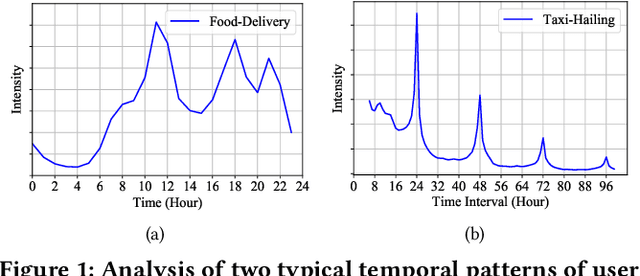
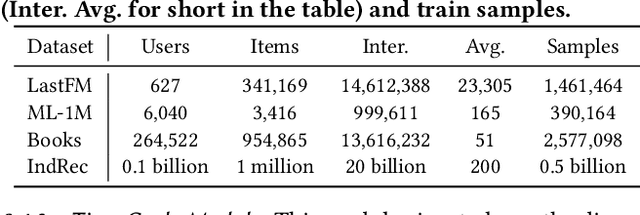
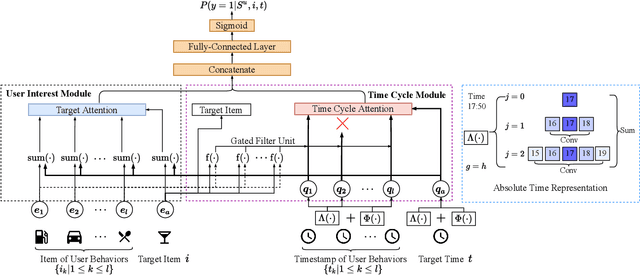

Abstract:Recently, modeling temporal patterns of user-item interactions have attracted much attention in recommender systems. We argue that existing methods ignore the variety of temporal patterns of user behaviors. We define the subset of user behaviors that are irrelevant to the target item as noises, which limits the performance of target-related time cycle modeling and affect the recommendation performance. In this paper, we propose Denoising Time Cycle Modeling (DiCycle), a novel approach to denoise user behaviors and select the subset of user behaviors that are highly related to the target item. DiCycle is able to explicitly model diverse time cycle patterns for recommendation. Extensive experiments are conducted on both public benchmarks and a real-world dataset, demonstrating the superior performance of DiCycle over the state-of-the-art recommendation methods.
LogicMP: A Neuro-symbolic Approach for Encoding First-order Logic Constraints
Sep 29, 2023Abstract:Integrating first-order logic constraints (FOLCs) with neural networks is a crucial but challenging problem since it involves modeling intricate correlations to satisfy the constraints. This paper proposes a novel neural layer, LogicMP, whose layers perform mean-field variational inference over an MLN. It can be plugged into any off-the-shelf neural network to encode FOLCs while retaining modularity and efficiency. By exploiting the structure and symmetries in MLNs, we theoretically demonstrate that our well-designed, efficient mean-field iterations effectively mitigate the difficulty of MLN inference, reducing the inference from sequential calculation to a series of parallel tensor operations. Empirical results in three kinds of tasks over graphs, images, and text show that LogicMP outperforms advanced competitors in both performance and efficiency.
Question Directed Graph Attention Network for Numerical Reasoning over Text
Sep 16, 2020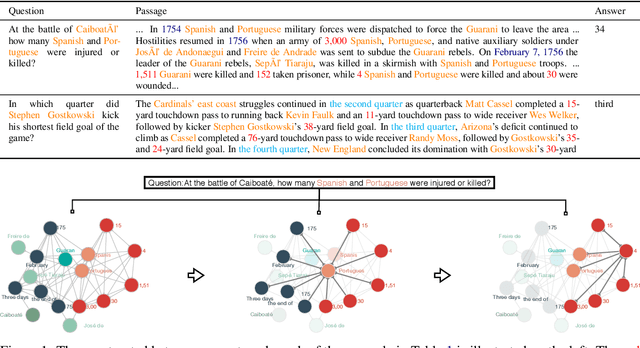

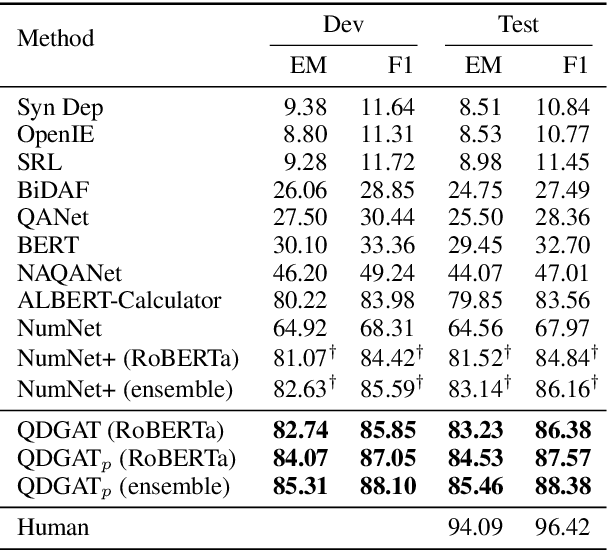
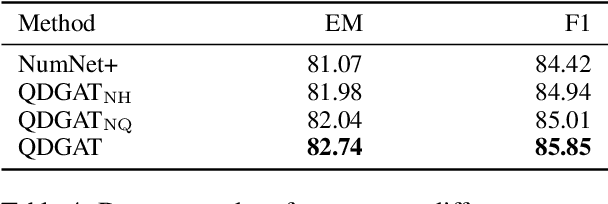
Abstract:Numerical reasoning over texts, such as addition, subtraction, sorting and counting, is a challenging machine reading comprehension task, since it requires both natural language understanding and arithmetic computation. To address this challenge, we propose a heterogeneous graph representation for the context of the passage and question needed for such reasoning, and design a question directed graph attention network to drive multi-step numerical reasoning over this context graph.
SpellGCN: Incorporating Phonological and Visual Similarities into Language Models for Chinese Spelling Check
May 13, 2020
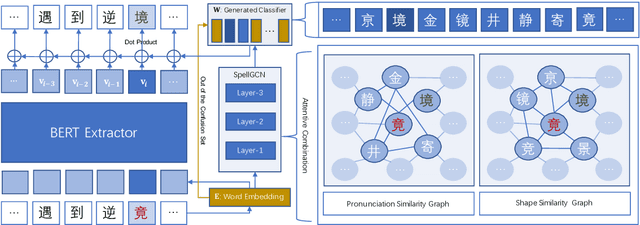
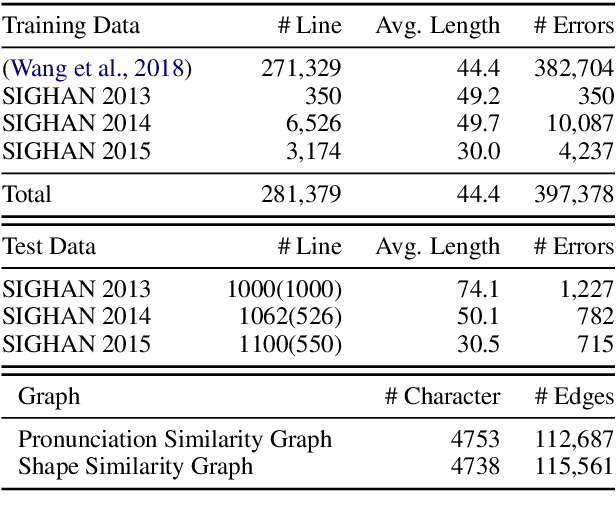
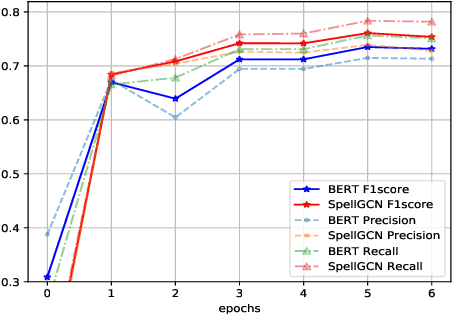
Abstract:Chinese Spelling Check (CSC) is a task to detect and correct spelling errors in Chinese natural language. Existing methods have made attempts to incorporate the similarity knowledge between Chinese characters. However, they take the similarity knowledge as either an external input resource or just heuristic rules. This paper proposes to incorporate phonological and visual similarity knowledge into language models for CSC via a specialized graph convolutional network (SpellGCN). The model builds a graph over the characters, and SpellGCN is learned to map this graph into a set of inter-dependent character classifiers. These classifiers are applied to the representations extracted by another network, such as BERT, enabling the whole network to be end-to-end trainable. Experiments (The dataset and all code for this paper are available at https://github.com/ACL2020SpellGCN/SpellGCN) are conducted on three human-annotated datasets. Our method achieves superior performance against previous models by a large margin.
Symmetric Regularization based BERT for Pair-wise Semantic Reasoning
Sep 08, 2019


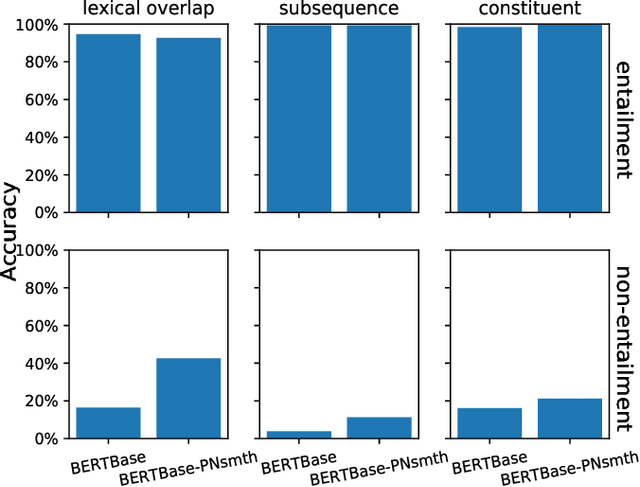
Abstract:The ability of semantic reasoning over the sentence pair is essential for many natural language understanding tasks, e.g., natural language inference and machine reading comprehension. A recent significant improvement in these tasks comes from BERT. As reported, the next sentence prediction (NSP) in BERT, which learns the contextual relationship between two sentences, is of great significance for downstream problems with sentence-pair input. Despite the effectiveness of NSP, we suggest that NSP still lacks the essential signal to distinguish between entailment and shallow correlation. To remedy this, we propose to augment the NSP task to a 3-class categorization task, which includes a category for previous sentence prediction (PSP). The involvement of PSP encourages the model to focus on the informative semantics to determine the sentence order, thereby improves the ability of semantic understanding. This simple modification yields remarkable improvement against vanilla BERT. To further incorporate the document-level information, the scope of NSP and PSP is expanded into a broader range, i.e., NSP and PSP also include close but nonsuccessive sentences, the noise of which is mitigated by the label-smoothing technique. Both qualitative and quantitative experimental results demonstrate the effectiveness of the proposed method. Our method consistently improves the performance on the NLI and MRC benchmarks, including the challenging HANS dataset~\cite{hans}, suggesting that the document-level task is still promising for the pre-training.
Semi-supervised Target-level Sentiment Analysis via Variational Autoencoder
Oct 24, 2018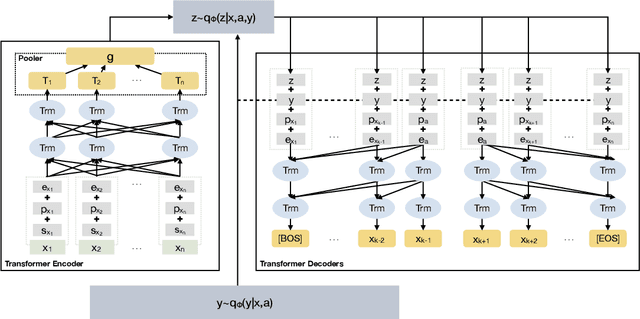

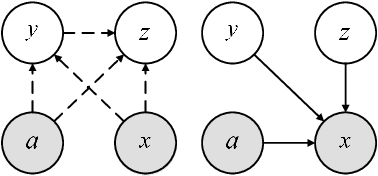

Abstract:Target-level aspect-based sentiment analysis (TABSA) is a long-standing challenge, which requires fine-grained semantical reasoning about a certain aspect. As manual annotation over the aspects is laborious and time-consuming, the amount of labeled data is limited for supervised learning. This paper proposes a semi-supervised method for the TABSA problem based on the Variational Autoencoder (VAE). VAE is a powerful deep generative model which models the latent distribution via variational inference. By disentangling the latent representation into the aspect-specific sentiment and the context, the method implicitly induces the underlying sentiment prediction for the unlabeled data, which then benefits the TABSA classifier. Our method is classifier-agnostic, i.e., the classifier is an independent module and various advanced supervised models can be integrated. Experimental results are obtained on the SemEval 2014 task 4 and show that our method is effective with four classical classifiers. The proposed method outperforms two general semi-supervised methods and achieves competitive performance.
Variational Autoencoders for Semi-supervised Text Classification
Nov 24, 2016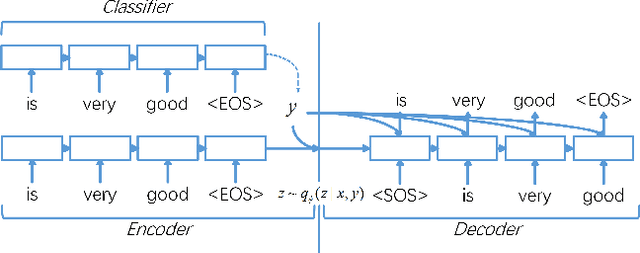

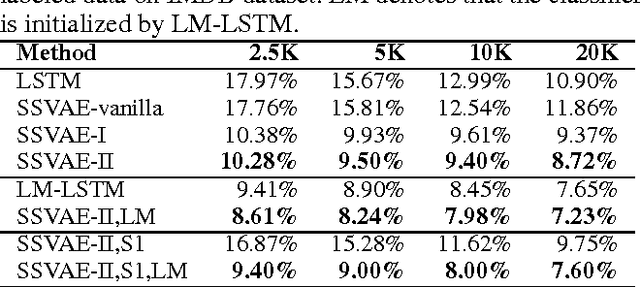
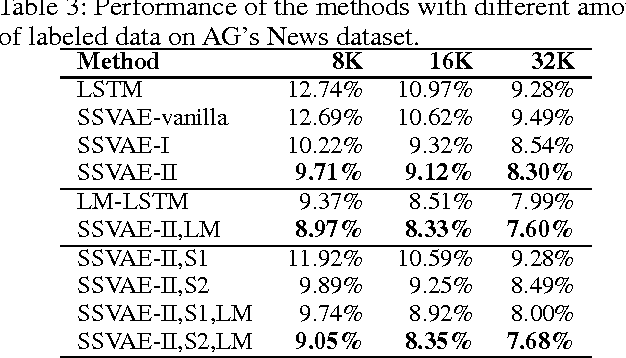
Abstract:Although semi-supervised variational autoencoder (SemiVAE) works in image classification task, it fails in text classification task if using vanilla LSTM as its decoder. From a perspective of reinforcement learning, it is verified that the decoder's capability to distinguish between different categorical labels is essential. Therefore, Semi-supervised Sequential Variational Autoencoder (SSVAE) is proposed, which increases the capability by feeding label into its decoder RNN at each time-step. Two specific decoder structures are investigated and both of them are verified to be effective. Besides, in order to reduce the computational complexity in training, a novel optimization method is proposed, which estimates the gradient of the unlabeled objective function by sampling, along with two variance reduction techniques. Experimental results on Large Movie Review Dataset (IMDB) and AG's News corpus show that the proposed approach significantly improves the classification accuracy compared with pure-supervised classifiers, and achieves competitive performance against previous advanced methods. State-of-the-art results can be obtained by integrating other pretraining-based methods.
 Add to Chrome
Add to Chrome Add to Firefox
Add to Firefox Add to Edge
Add to Edge